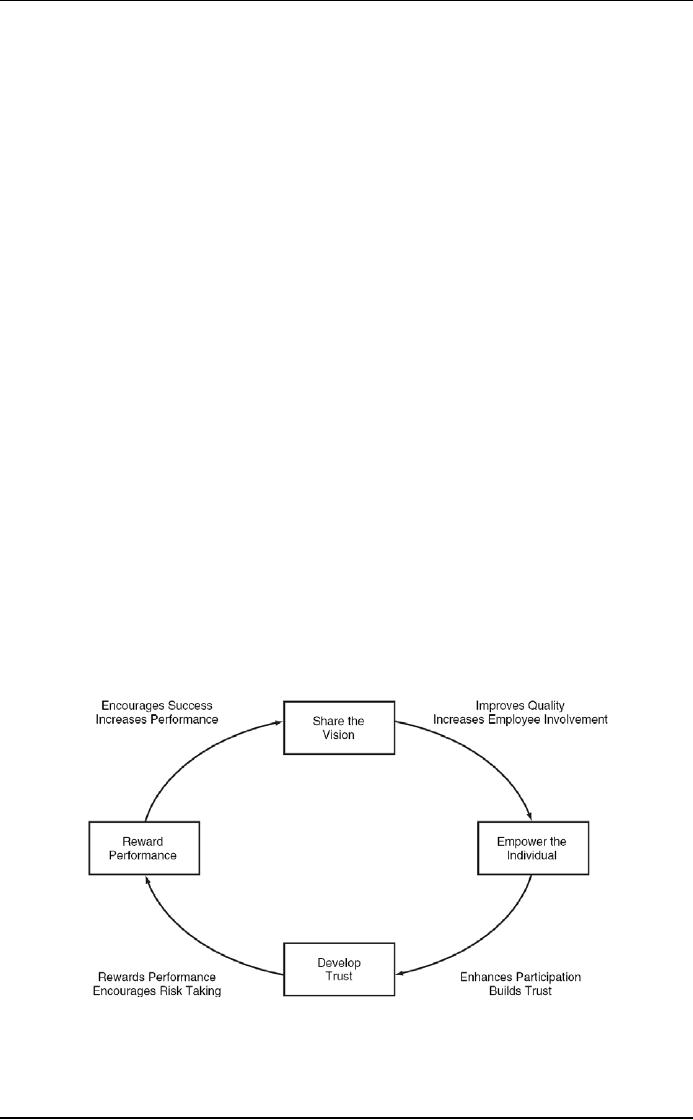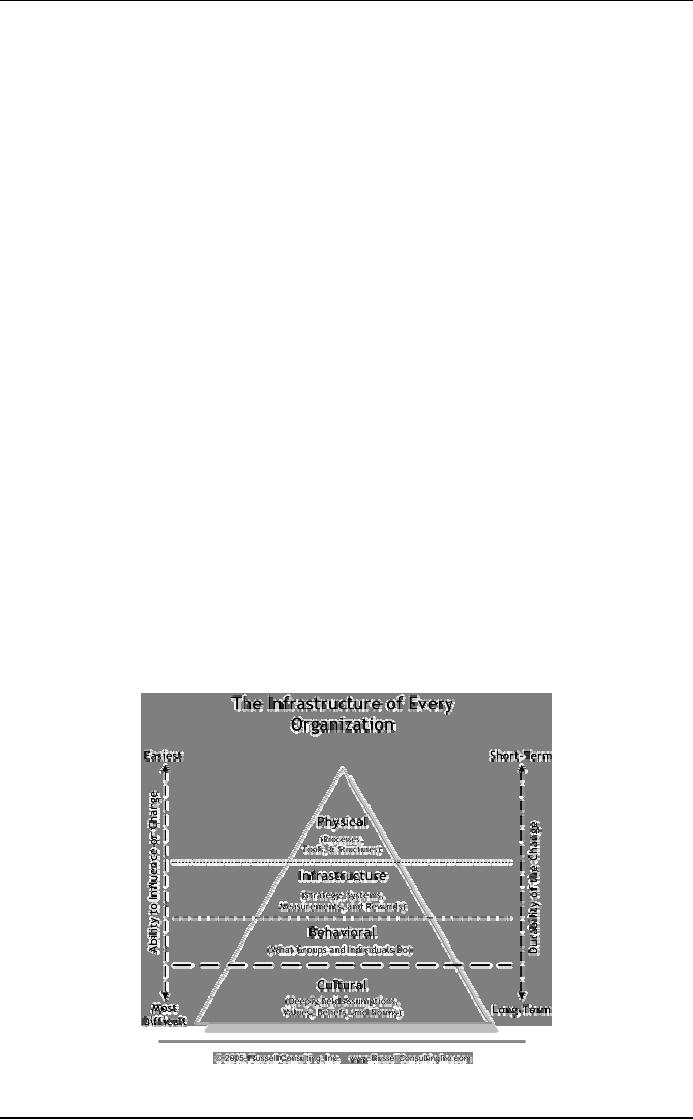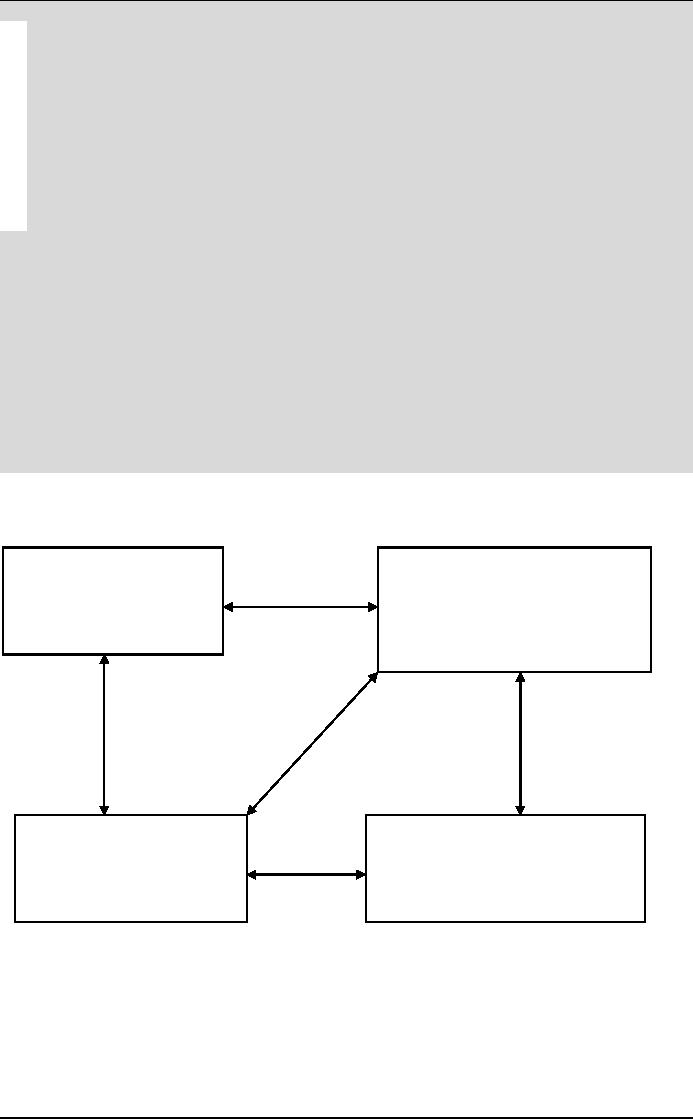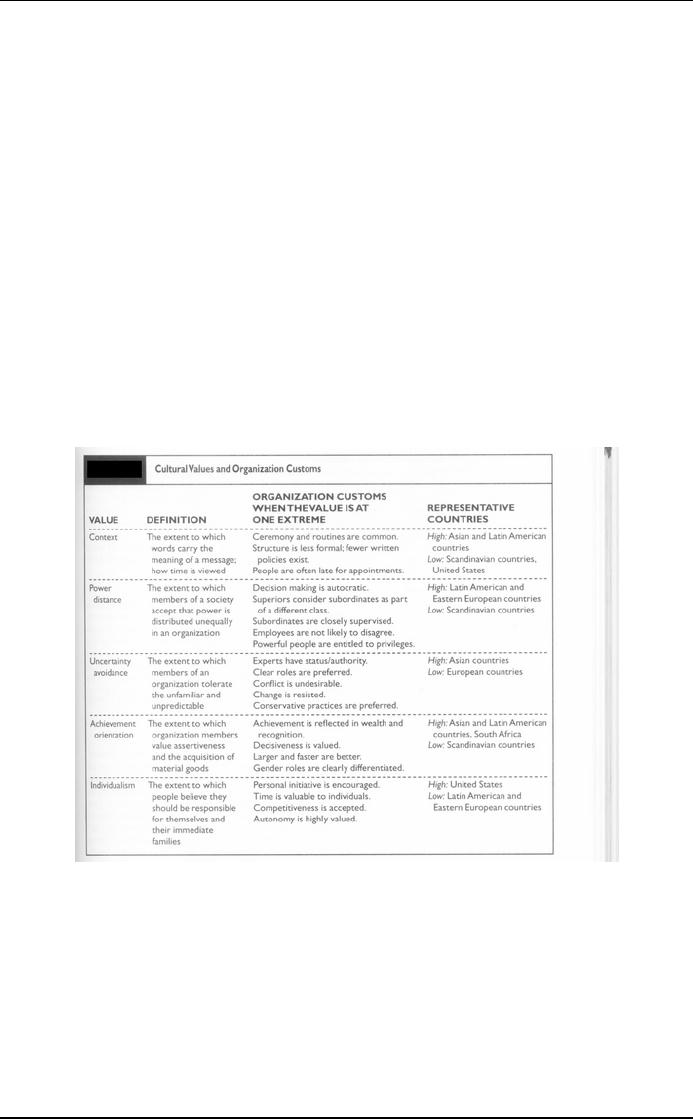 |

Organization
Development MGMT
628
VU
Lesson
# 43
Organization
Transformation
The
distinguishing features of the revolutionary
change efforts are:
·
Change
is Triggered by Environmental and
Internal Disruptions
·
Change
is Systemic and
Revolutionary
·
Change
Demands a New Organizing
Paradigm
·
Change
is Driven by Senior Executives
and Line Management.
·
Continuous
Learning and Change.
Organization
transformations can occur in response to
or in anticipation of major changes in
the
organization's
environment or technology.
In
addition, these changes
often are associated with
significant alterations in the firm's business
strategy,
which,
in turn, may require modifying corporate
culture as well as internal structures
and processes to
support
the new direction. Such fundamental
change entails a new
paradigm for organizing and
managing
organizations.
It involves qualitatively different
ways of perceiving, thinking, and
behaving in organizations.
Movement
toward this new way of operating
requires top managers to
take an active leadership role.
The
change
process is characterized by considerable
innovation and learning and
continues almost
indefinitely
as
organization members discover new
ways of improving the organization and
adapting it to changing
conditions.
Organization
transformation is a recent advance in
organization development, and there is
some confusion
about
its meaning and
definition.
Characteristics
of Transformational Change
In
the past decade, a large number of
organizations radically altered
how they operate and relate
to their
environments.
Increased foreign competition forced
many industries to downsize
and become leaner,
more
efficient,
and flexible. Deregulation
pushed organizations in the financial
services, telecommunications,
and
airline
industries to rethink business
strategies and reshape how
they operate. Public demand for
less
government
and lowered deficits forced public sector
agencies to streamline operations and to
deliver more
for
less. Rapid changes in
technologies rendered many organizational
practices obsolete, pushing firms
to
be
continually innovative and
nimble.
Organization
transformation implies radical
changes in how members
perceive, think, and behave
at work.
These
changes go far beyond making the existing organization
better or fine-tuning the status quo.
They
are
concerned with fundamentally altering the
organizational assumptions about its
functioning and how
it
relates
to the environment.
Changing
these assumptions entails significant
shifts in corporate philosophy and
values and in the
numerous
structures and organizational
arrangements that shape
members' behaviors. Not only
is the
magnitude
of change greater, but the
change fundamentally alters the
qualitative nature of the
organization.
Examination
of the rapidly growing literature on the
topic suggests, however, the following
distinguishing
features
of these revolutionary change
efforts.
Change
is Triggered by Environmental and Internal
Disruptions
Organizations
are unlikely to undertake
transformational change unless significant
reasons to do so emerge.
Power,
and expertise are vested in
the existing organizational arrangements, and when
faced with problems,
members
are more likely to fine-tune
those structures than to alter them
drastically. Thus, in most
cases,
organizations
must experience or anticipate a severe
threat to survival before they will be motivated
to
undertake
transformational change. Such threats
arise when environmental and
internal changes
render
existing
organizational strategies and designs
obsolete. The changes threaten the very
existence of the
organization
as it presently is constituted.
Transformational
change occurs in response to at
least three kinds of
disruption:
1.
Industry discontinuities--sharp
changes in legal, political,
economic, and technological
conditions
that
shift the basis for
competition within
industries

Organization
Development MGMT
628
VU
2.
Product life cycle shifts--changes in
product life cycle that
require different business
strategies
3.
Internal company dynamics--changes in
size, corporate portfolio strategy,
executive turnover,
and
the
like.
These
disruptions severely jolt organizations
and push them to alter business
strategy and, in turn,
their
mission,
values, structure, systems,
and procedures.
Change
is Systemic and Revolutionary
Transformational
change involves reshaping the
organization's culture and design
elements. These
changes
can
be characterized as systemic and
revolutionary because the entire nature
of the organization is altered
fundamentally.
Typically
driven by senior executives,
change may occur rapidly so
that it does not get mired
in politics,
individual
resistance, and other forms of
organizational inertia. This is particularly pertinent to
changing the
different
features of the organization, such as
structure, information systems,
human resources
practices,
and
work design. These features
tend to reinforce one another,
thus making it difficult to change them
in a
piecemeal
manner. They need to be changed together
and in a coordinated fashion so that they
can
mutually
support each other and the
new cultural values and
assumptions. Transformational
change,
however,
is distinguished from other
types of strategic change by
its attention to the people side of
the
organization.
For a change to be labeled
transformational, a majority of individuals in an
organization must
change
their behavior.
Long-term
studies of organizational evolution
underscore the revolutionary nature of
transformational
change.
They suggest that
organizations typically move through
relatively long periods of smooth
growth
and
operation. These periods of
convergence or evolution are
characterized by incremental changes.
At
times,
however, most organizations experience
severe external or internal disruptions
that render existing
organizational
arrangements ineffective. Successful
firms respond to these threats to
survival by
transforming
themselves to fit the new conditions.
These periods of total
system and quantum
changes
represent
abrupt shifts in the organization's
structure, culture, and processes. If
successful, the shifts
enable
the
organization to experience another long
period of smooth functioning until the
next disruption
signals
the
need for drastic
change.
These
studies of organization evolution and
revolution point to the benefits of
implementing
transformational
change as rapidly as possible.
The faster the organization can
respond to disruptions, the
quicker
it can attain the benefits of operating in a new
way. Rapid change enables
the organization to reach
a
period of smooth growth and
functioning sooner, thus
providing it with a competitive
advantage over
those
firms that change more
slowly.
Change
Demands a New Organizing
Paradigm
Organizations
undertaking transformational change are, by
definition, involved in second-order or
gamma
types
of change. Gamma change
involves discontinuous shifts in mental
or organizational frameworks.
Creative
metaphors, such as "organization
learning" or "continuous improvement,"
often are used to
help
members
visualize the new paradigm.
During the 1980s, increases in
technological change, concern
for
quality,
and worker participation led to at
least one shift in organizing
paradigm. Characterized as the
transition
from a "control-based" to a "commitment-based"
organization, the features of the new
paradigm
included
leaner, more flexible
structures; information and
decision making pushed down to the
lowest
levels;
decentralized teams and
business units accountable for
specific products, services, or
customers; and
participative
management and teamwork. This new
organizing paradigm is well suited to
changing
conditions.
Change
is Driven by Senior Executives and Line
Management
A
key feature of organization
transformation is the active role of
senior executives and line
managers in all
phases
of the change process. They are
responsible for the strategic
direction and operation of
the
organization
and actively lead the transformation. They
decide when to initiate transformational
change,
what
the change should be, how it should be
implemented, and who should be
responsible for directing
it.
Because
existing executives may lack the talent,
energy, and commitment to undertake
these tasks, they may
be
replaced by outsiders who
are recruited to lead the change.
Research on transformational
change
suggests
that externally recruited executives are
three times more likely to
initiate such change than
are
existing
executive teams.
The
critical role of executive leadership in
transformational change is clearly
emerging. Three key roles
for
executive
leadership of such change
are:

Organization
Development MGMT
628
VU
1.
Envisioning. Executives
must articulate a clear and
credible vision of the new strategic
orientation. They
also
must set new and
difficult standards for
performance, and generate
pride in past accomplishments
and
enthusiasm
for the new strategy.
Executives
must:
articulate
a clear and credible vision of the
new strategic
orientation,
set
new and difficult standards
for performance,
generate
pride in past accomplishments,
and
enthusiasm
for the new strategy.
Sharing
the Vision
The
development of a vision is an important
element in organizational and cultural
change. Many
management
theorists feel that vision is the very
essence of leadership. Any attempt at
changing a culture
should
begin with a clear vision of the
new strategy and what it
will take to make it work.
Organizations are
driven
by a vision, not by directives
from the chain of
command.
Vision
is "a mental image of a possible
and desirable future of the
organization... that articulates a
view of
a
realistic, credible, attractive future
for the organization. An effective vision should be
challenging,
inspiring,
and aimed at empowering people at all
levels.
The
fact of the matter is that the fast
food employee flipping
burgers and waiting on the
customer is the
one
who ultimately carries out
the vision, not the owner and
management team at the
headquarters.
Developing
a shared vision involves
several stages:
Share
the vision. People
will buy into a clear
challenging vision that has
meaning for
them
and will improve
society.
Empower
the individual. People
need to feel they have a stake in the
outcome and have
participated
in defining the vision. The
idea is to have individual
purposes congruent with
the
organization's vision.
Develop
Trust. An effective
vision must set goals
for challenging performance,
but must
allow
people to "buy in" to the vision
and provide feedback on
performance.
Reward
performance. High
performers need to be recognized. This
element also
includes
support for taking risk,
providing the freedom to fail, and
pushing decision-
making
information downward to the lower
levels.
Figure
55
2.
Energizing. Executives
must demonstrate personal
excitement for the changes
and model the
behaviors
that are expected of others.
They must communicate examples of
early success to
mobilize
energy
for change.

Organization
Development MGMT
628
VU
3.
Enabling. Executives
must provide the resources
necessary for undertaking significant
change and use
rewards
to reinforce new behaviors. Leaders
also must build an effective
top-management team to
manage
the
new organization and develop management
practices to support the change
process.
If
the system rewards the old culture,
old practices, then it won't
make sense for people to
change. This, of
course,
includes pay and promotion,
but other incentives as
well.
For
example, a TV manufacturing company
rewards top performers by putting them on
an "elite badge"
project
team. At a computer company, awards &
recognition were used to
gain employee involvement,
and
people
were willing to work extra
hours to bring out products.
They wore T-shirts with mottos
that
celebrated
their dedication, like "working
ninety hours a week and
loving it."
Leaders
also must build an effective
top-management team to manage the
new organization and develop
management
practices to support the change
process.
Continuous
Learning and Change
Transformational
change requires considerable
innovation and learning. Organizational
members must
learn
how to enact the new
behaviors required to implement new
strategic directions. This typically is
a
continuous
learning process of trying new
behaviors, assessing their
consequences, and modifying them
if
necessary.
Because members usually must
learn qualitatively different
ways of perceiving, thinking,
and
behaving,
the learning process is likely to be
substantial and to involve
much unlearning. It is directed by
a
vision
of the future organization and by the
values and norms needed to
support it. Learning occurs at
all
levels
of the organization, from senior
executives to lower-level
employees.
Because
the environment itself is likely to be
changing during the change
process, transformational change
rarely
has a delimited timeframe
but is likely to persist as
long as the firm needs to
adapt to change.
Learning
how to manage change in a continuous
manner can help the organization
keep pace with a
dy-
namic
environment. It can provide the
built-in capacity to fit the organization
continually to its
environment.
Three
kinds of Interventions
1.
Culture change
2.
Self-design
3.
Organization learning and knowledge
management.
It
describes activities directed at
changing the basic character or culture
of the organization.
Culture
Change
Figure
56

Organization
Development MGMT
628
VU
Despite
the increased attention and
research devoted to corporate culture, there is
still some confusion
about
what the term culture really means when
applied to organizations. Examination of the
different
definitions
suggests that organization culture is the pattern of
basic assumptions, values,
norms, and
artifacts
shared by organization members. These
shared meanings help members
make sense out of
everyday
life in the organization. The meanings
signal how work is to be done
and evaluated, and
how
employees
are to relate to each other
and to significant others, such as
customers, suppliers,
and
government
agencies.
Levels
of Organizational Culture
As
shown below, organization culture
includes four major elements existing at
different levels of
awareness:
1.
Artifacts.
2.
Norms
3.
Values
4.
Basic Assumptions
Figure
57
Artifacts
Norms
Values
Basic
Assumptions
Case:
The Action Company
The
"Action Company" is a rapidly
growing high high-technology
manufacturing concern with
low
turnover
and intense history. A
visitor to the Company would
note the open landscape architecture; a
high
degree
of informality; frenetic activity all
around; an obvious lack of status
symbol, such as parking
spaces
or
executive dinning rooms; and
a sense of high energy and
emotional evolvement of people staying
late
and
expressing excitement about the importance of
their work.
If
one asks about the various
norms, one is told that the
company is in a rapidly growing
high-technology
field
where hard work, innovation,
and rapid solutions to things are
important and where it is
essential for
everyone
to contribute at their maximum
capacity. New employees are
carefully screened; and when
an
employee
fails, he or she is simply
assigned to another task, not
fired or punished in any
personal way.
The
next-deeper level of awareness includes
values about what ought to be in
organizations. Values
tell
members
what is important in the organization and what
deserves their
attention.

Organization
Development MGMT
628
VU
An
organization's culture may be described by a
set of core values that
include:
·
Individual
autonomy. The
degree of responsibility, independence,
and opportunities for
exercising
initiative for members of the
organization.
·
Sensitivity
to the needs of customers and
employees. The
degree of responsiveness to
changing
needs.
·
Support. The
degree of assistance provided by
managers.
·
Interest
in having employees initiate
new ideas. The
degree to which employees
are
encouraged
and empowered to come up
with better quality and
productivity suggestions.
·
Openness
of available communication
channel. The
degree of freedom of communication
between
members and teams and
levels.
·
Risk
behavior. The
degree to which members are
encouraged to be aggressive, innovative,
and
risk-taking.
By
combining these values a
composite picture of the organization's culture is
formed. The culture
becomes
the basis for the shared
understanding that members
have about the organization, how things
are
done,
and the way they are
supposed to behave.
The
company operates on several critical
and coordinated basic assumptions:
(a) Individuals are assumed
to
be
the source of all innovation
and productivity. (b) It is assumed
that truth can only be
determined by
pitting
fully involved individuals
against each other to debate
ideas until only one
idea survives; and it
is
further
assumed that ideas will
not be implemented unless everyone
involved in implementation has
been
convinced
through the debate of the validity of the
idea; (c) Paradoxically, it is
also assumed that
every
individual
must think for himself or
herself and "do the right
thing" even if that means
disobeying one's
boss
or violating a policy. (d) What
makes it possible for people to
live in this high conflict
environment is
the
assumption that the company
members are one big
family who will take
care of each other and
protect
each
other even if some members
make mistakes or have bad
ideas.
Figure
58
Individual
is source of
Truth
is discovered through
good
ideas
debate
and testing
Every
person must
We
are one family
think
for himself
who
will take care
or
herself and
of
each other
"do
the right thing"
Cultural
Context
Researchers
have proposed that applying
OD in different countries requires a
"context-based" approach to
planned
change. This involves fitting the
change process to the organization's
cultural context, including
the
values held by members in the particular
country or region. These beliefs
inform people about which
behaviors
are important and acceptable
in their culture. Cultural values play a
major role in shaping the
customs
and practices that occur
within organizations as well, influencing
how members react to
phenomena
having to do with power, conflict,
ambiguity, time, and
change.

Organization
Development MGMT
628
VU
There
is a growing body of knowledge about
cultural diversity and its effect on organizational
and
management
practices. Researchers have
identified five key values
that describe national
cultures and
influence
organizational customs: context
orientation, power distance, uncertainty
avoidance, achievement
orientation,
and individualism (Table
24).
Context
Orientation
This
value describes how
information is conveyed and time is
valued in a culture. In low-context
cultures,
such
as Scandinavia and the United
States, information is communicated in
words and phrases. By
using
more
specific words, more meaning
is expressed. In addition, time is viewed
as discrete and
linear--as
something
that can be spent, used,
saved, or wasted.
In
high-context cultures, on the other
hand, the communication "medium reflects
the message more than
the
words, and time is a fluid
and flexible concept. For
example, social cues in
Japan and Venezuela
provide
as
much, if not more,
information about a particular situation
than do words alone.
Organizations
in high-context cultures emphasize
ceremony and ritual. How
one behaves is an
important
signal
of support and compliance with the
way things are done.
Structures are less formal
in high-context
cultures;
there are few written
policies and procedures to
guide behavior.
Because
high-context cultures view time as
fluid, punctuality for appointments is
less a priority than
is
maintaining
relationships.
Table
24
Power
Distance
This
value concerns the way people
view authority, status
differences, and influence patterns.
People in
high
power distance regions, such as
Latin America and Eastern
Europe, tend to favor
unequal
distributions
of power and influence, and consequently
autocratic and paternalistic
decision-making
practices
are accepted. Organizations in high power
distance cultures tend to be
highly centralized
with
several
hierarchical levels and a
large proportion of supervisory
personnel. Subordinates in
these
organizations
represent a lower social
class. They expect to be
supervised closely and
believe that power
holders
are entitled to special
privileges. Such practices
would be inappropriate in low power
distance
regions,
such as Scandinavia, where
participative decision making and
egalitarian methods prevail.
Uncertainty
Avoidance
This
value reflects a preference
for conservative practices
and familiar and predictable
situations. People in
high
uncertainty avoidance regions, such as
Asia, prefer stable routines,
resist change, and act to
maintain

Organization
Development MGMT
628
VU
the
status quo. They do not like
conflict and believe that
company rules should not be
broken. In regions
where
uncertainty avoidance is low, such as in
many European countries, ambiguity is
less threatening.
Organizations
in these cultures tend to favor
fewer rules, higher levels of
participation in decision
making,
more
organic structures, and more
risk taking.
Achievement
Orientation
This
value concerns the extent to which the
culture favors the acquisition of power and
resources.
Employees
from achievement-oriented cultures, such
as Asia and Latin America,
place a high value on
career
advancement, freedom, and salary
growth. Organizations in these cultures
pursue aggressive
goals
and
have high levels of stress
and conflict. Organizational success is
measured in terms of size,
growth, and
speed.
On the other hand, workers in
cultures where achievement is
less of a driving value,
such as those in
Scandinavia,
prize the social aspects of
work including working
conditions and supervision,
and typically
favor
opportunities to learn and grow at
work.
Individualism
This
value is concerned with
looking out for oneself as
opposed to one's group or organization.
In high
individualism
cultures, such as the United
States and Canada, personal
initiative and competitiveness
are
valued
strongly. Organizations in individualistic
cultures often have high
turnover rates and
individual
rather
than group decision-making processes.
Employee empowerment is supported when
members
believe
that it improves the probability of
personal gain. These
cultures encourage personal
initiative,
competitiveness,
and individual autonomy.
Conversely, in low individualism
countries, such as
Taiwan,
Japan,
and Peru, allegiance to
one's group is paramount. Organizations operating in
these cultures tend to
favor
cooperation among employees and
loyalty to the company.
Table of Contents:
- The Challenge for Organizations:The Growth and Relevance of OD
- OD: A Unique Change Strategy:OD consultants utilize a behavioral science base
- What an “ideal” effective, healthy organization would look like?:
- The Evolution of OD:Laboratory Training, Likert Scale, Scoring and analysis,
- The Evolution of OD:Participative Management, Quality of Work Life, Strategic Change
- The Organization Culture:Adjustment to Cultural Norms, Psychological Contracts
- The Nature of Planned Change:Lewin’s Change Model, Case Example: British Airways
- Action Research Model:Termination of the OD Effort, Phases not Steps
- General Model of Planned Change:Entering and Contracting, Magnitude of Change
- The Organization Development Practitioner:External and Internal Practitioners
- Creating a Climate for Change:The Stabilizer Style, The Analyzer Style
- OD Practitioner Skills and Activities:Consultant’s Abilities, Marginality
- Professional Values:Professional Ethics, Ethical Dilemmas, Technical Ineptness
- Entering and Contracting:Clarifying the Organizational Issue, Selecting an OD Practitioner
- Diagnosing Organizations:The Process, The Performance Gap, The Interview Data
- Organization as Open Systems:Equifinality, Diagnosing Organizational Systems
- Diagnosing Organizations:Outputs, Alignment, Analysis
- Diagnosing Groups and Jobs:Design Components, Outputs
- Diagnosing Groups and Jobs:Design Components, Fits
- Collecting and Analyzing Diagnostic information:Methods for Collecting Data, Observations
- Collecting and Analyzing Diagnostic information:Sampling, The Analysis of Data
- Designing Interventions:Readiness for Change, Techno-structural Interventions
- Leading and Managing Change:Motivating Change, The Life Cycle of Resistance to Change
- Leading and managing change:Describing the Core Ideology, Commitment Planning
- Evaluating and Institutionalizing Organization Development Interventions:Measurement
- Evaluating and Institutionalizing Organization Development Interventions:Research Design
- Evaluating and Institutionalizing Organization Development Interventions
- Interpersonal and Group Process Approaches:Group Process
- Interpersonal and Group Process Approaches:Leadership and Authority, Group Interventions
- Interpersonal and Group Process Approaches:Third-Party Interventions
- Interpersonal and Group Process Approaches:Team Building, Team Building Process
- Interpersonal and Group Process Approaches:Team Management Styles
- Organization Process Approaches:Application Stages, Microcosm Groups
- Restructuring Organizations:Structural Design, Process-Based Structures
- Restructuring Organizations:Downsizing, Application Stages, Reengineering
- Employee Involvement:Parallel Structures, Multiple-level committees
- Employee Involvement:Quality Circles, Total Quality Management
- Work Design:The Engineering Approach, Individual Differences, Vertical Loading
- Performance Management:Goal Setting, Management by Objectives, Criticism of MBO
- Developing and Assisting Members:Career Stages, Career Planning, Job Pathing
- Developing and Assisting Members:Culture and Values, Employee Assistance Programs
- Organization and Environment Relationships:Environmental Dimensions, Administrative Responses
- Organization Transformation:Sharing the Vision, Three kinds of Interventions
- The Behavioral Approach:The Deep Assumptions Approach
- Seven Practices of Successful Organizations:Training, Sharing Information